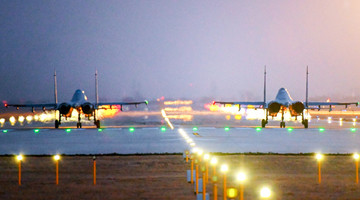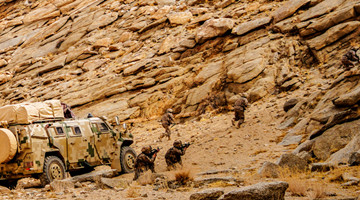By Bai Mengchen
On August 3, some competitions of the “International Army Games (IAG) 2019” hosted by the Chinese PLA Ground Force opened in Korla, northwest China’s Xinjiang Uygur Autonomous Region, with 20 teams from 11 countries participating.
This year, in addition to hosting four competitions, namely “Suvorov Attack” as Infantry Fighting Vehicle(IFV) Crew Competition, “Clear Sky” as Man-Portable Air Defense Missile Teams Competition, “Gunsmith Master” as Weapon Repair Competition and “Safe Environment” as Nuclear Biological and Chemical (NBC) Reconnaissance Teams Competition, China also dispatched its Ground Force, Navy and Air Forces teams to five countries including Russia and Kazakhstan to participate in 11 competitions such as “Tank Biathlon” and “Airborne Platoon”. Also for the first time, the Ground Force sent teams to Kazakhstan and Mongolia to watch two competitions.
Chinese side has achieved remarkable results in promoting training through competitions
As one of IAG’s iconic events, the “Tank Biathlon” competition started from the earliest stage, and each movement of the participating teams attracted wide attention. According to information released by the Russian Ministry of Defense, China dispatched four 96B main battle tanks(MBTs) to participate in the competition this year.
From the results of previous years, China’s 96B MBTs and Russia’s T-72B3 MBTs represent the highest level of the second generation tank improvement, and play an obvious guiding role in upgrading the same series of tanks equipped by the two countries.
On August 5, one of Chinese two vehicle teams driving 96B tanks did very well in the second round of the group match and hit all the targets in all the shooting links. Especially in the static firing of the main gun, three shells all hit the targets and won a lot of applause. Eventually, the team won first place in the group clocking 18 minutes and 57 seconds, setting the best record for Chinese teams in years.
On August 8, the individual vehicle stage of the “Tank Biathlon” competition was over, and the Chinese team entered the semi-finals smoothly. Russian media reported that in this competition, Chinese team’s performance has steadily improved year by year, which shows that the Chinese military has made great efforts in training to promote the effectiveness through the competition and truly achieved the realm of “human-vehicle integration”.
New Russian military equipment appeared in the arena
The Russian military came to China, competing with a large amount of its domestic equipment. In the “Clear Sky” as Man-Portable Air Defense Missile Teams Competition, the Russian teams brought a number of new equipment, including “Typhoon” wheeled armored transport vehicle and “Needle-S” portable air defense missile. Among them, “Typhoon” is specially modified for the Russian Army air defense missile force, and participates in the IAG for the first time.
The vehicle has a total combat weight of 13.5 tons, a vehicle length of 5.93 meters, a driving mode of 4*4, a maximum speed of 90 km/h, a trench width of not less than 0.5 meters, a vertical obstacle crossing not less than 20 degrees, and a dual-purpose machine gun of 12.7 mm high-level.
The “Needle-S” portable air defense missile is 1.6 meters long, 0.07 meters in diameter, and 18.25 kilograms in weight. The missile flies at a maximum speed of 570 meters per second and has a range of 500 to 6,000 meters. It adopts passive infrared homing guidance mode. These two types of equipment quickly attracted worldwide attention once appearing on the competition.
However, the Russian military still uses the equipment provided by China in most subjects. For example, in the “Safe Environment” as Nuclear Biological and Chemical (NBC) Reconnaissance Teams Competition, the Russian Army, like the participants from Belarus, Venezuela, Egypt, Uzbekistan and Mongolia, used the new chemical and radiological reconnaissance vehicle and poison detection equipment provided by the Chinese side.
It is worth mentioning that in 2018, Chinese chemical-defense soldiers took this type of chemical and radiological reconnaissance vehicle to Russia to participate in the competition, which aroused the interest of Russian participants at that time. This time, when they come to Xinjiang, they finally have a chance to experience it comprehensively.
The competition environment in each regional arena is more challenging
With more and more countries joining the IAG, the competition environment becomes more challenging. This year, for the first time, India hosted the “Army Scout Masters” competition, which mainly tests the special forces’ reconnaissance combat skills.
In the competition, the scouts of participating countries need to pass a dangerous obstacle track to complete various enemy rear combat tasks one by one. Special forces need to display their various skills in reconnaissance, communications, explosion, armed swimming, orienteering, driving infantry fighting vehicle, shooting multi-weapons, flying knife and spade, helicopter fast-roping penetration, and nuclear, biological and chemical (NBC) protection.
China has been invited to participate in the competition for five consecutive years. This year’s competition in India poses a new challenge to the scouts of all the participating countries - because the highest temperature in summer in the Jaisalmer area, where the competition is hosted, reaches 49℃(120.2℉), and even breaks through 52℃(125.6℉) in some areas.
Russian Deputy Minister of Defence Yunus-Bek Yevkuro, who attended the opening ceremony of the competition, told Russian media that the high temperature in India would pose new challenges to all the participants.









